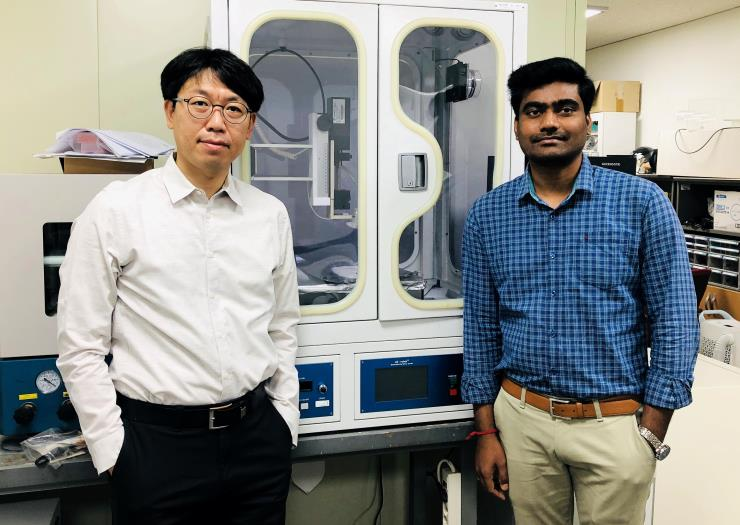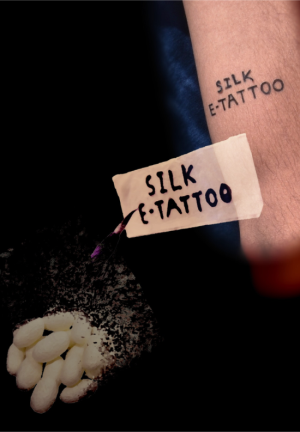- About Ajou
- Admission
- Academics
- Research
-
International
International
- Campus Life
-
News and Event
News and Event
- AUT
Major Research Result
NEW Prof. Kim Sung-hwan Develops Multifunctional Silk Protein-based Electronic Tattoos
- 2021-07-01
- 7427

Ajou University and Panoptics, a provider specialized in optics, have succeeded in developing multifunctional electronic tattoos using silk protein nanofibers. The invention is expected to be a next-generation healthcare device, enabling diagnosis and drug injection after attachment to uneven skin tissues after drawing the needed circuits on the skin.
Prof. Kim Sung-hwan, Departments of Physics and Energy Systems Research (pictured left), announced successful development of electronic tattoos, making it possible to draw circuits on silk protein nanofibers with carbon nanofiber ink.
The achievement was entitled, “Multifunctional and Ultrathin Electronic Tattoo for On-Skin Diagnostic and Therapeutic Applications,” and appeared on the Frontispiece page of the online edition of Advanced Materials, a prestigious international journal focused on materials science, on May 6. The research was conducted in collaboration with Panoptics. Primarily authored by Prof. Narendar Gogurla, Research Assistant Professor (pictured right), it was also written together with Mr. Kim Jang-sun, CEO of Panoptics, and three other authors.
There is a fast-growing body of research worldwide on materials for next-generation electronic healthcare devices, as such devices are capable of detecting and analyzing vital signs automatically. Electronic materials that can provide as much flexibility and elasticity as actual human skin are needed and countless researchers have dedicated themselves to developing materials and devices that combine flexible substrates with electrodes and electronics to read and analyze vital signs from the human body. These materials are known as “electronic skin” today.
Finding the right interface between electronic skin and actual human skin that can attach flawlessly to uneven skin surfaces, such as finger pads, and have enhanced biocompatibility is vital. Ultrathin electronic circuits using biocompatible materials have been very challenging to develop.
Prof. Kim’s team sought to resolve this problem with proteins—particularly silk proteins available from natural sources. Protein derived from silkworms is a skin-friendly and high-molecular biomaterial with superior physical and chemical properties.
In the first step, the researchers make silk nanofiber paper, with a thickness equivalent to one-fiftieth of a strand of human hair, using electrospinning. Afterwards, they draw circuits on the silk nanofiber paper using carbon nanofiber ink and brush. Once the ink dries, the drawn circuits come out. If the circuits are placed on slightly moist skin, this creates the electronic tattoos.
These electronic tattoos are ultrathin and can be put on finely-wrinkled skin surfaces like finger pads while maintaining stability in their electric properties during our everyday activities, besides taking showers. Electronic tattoos are simple to wipe off with wet wipes. Materials derived from carbon nanofibers are harmless as the silk nanofibers are injected into the middle of the electronic tattoos.
Electronic tattoos, as they are attached to the skin, can be used as electrodes for electrocardiography or electromyography. They can also be used in thermal therapy or drug injections. Weak electric currents transmitted to the electronic tattoos or exposing the tattoos to sunlight creates a certain level of heat through carbon nanofibers.
The fact that light can be used to create heat means that electronic tattoos can be heated remotely, implying a broad and diverse scope of application. Together with the ability to inject drugs into silk proteins, controlling the temperature of the tattoos remotely will increase the efficiency of drug injections.
Prof. Kim explained: “Although there has been significant progress in research on harvesting energy from the human body, the problems related to human-machine interfacing have been relatively neglected. Using proteins, of which natural skin is composed, interfaces capable of bridging the material difference between the human body and electronic devices can be developed.”
He also added: “Our project is significant in that our invention can help increase the application of biomaterials to a variety of electronic devices. We hope to see our product applied to a wide range of healthcare products and soft robotics in the future.”
Sponsored by the National Research Foundation of Korea, the BK21 FOUR, the Gyeonggi-do Regional Research Center (GRRC), and the Korea Institute of Energy Technology Evaluation and Planning, the electronic tattoo technology was developed in partnership with Panoptics. Patent applications in Korea and technology transfer have been approved as well.

A conceptual image of silk protein-based electronic tattoos
Circuits drawn with carbon nanofiber ink on silkworm-derived silk paper can be attached to the skin like a tattoo.
